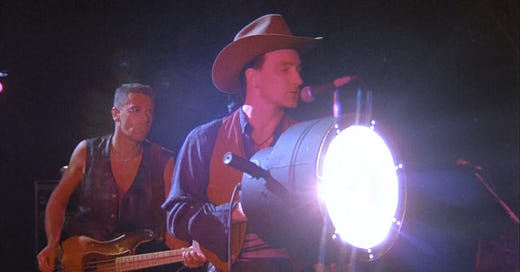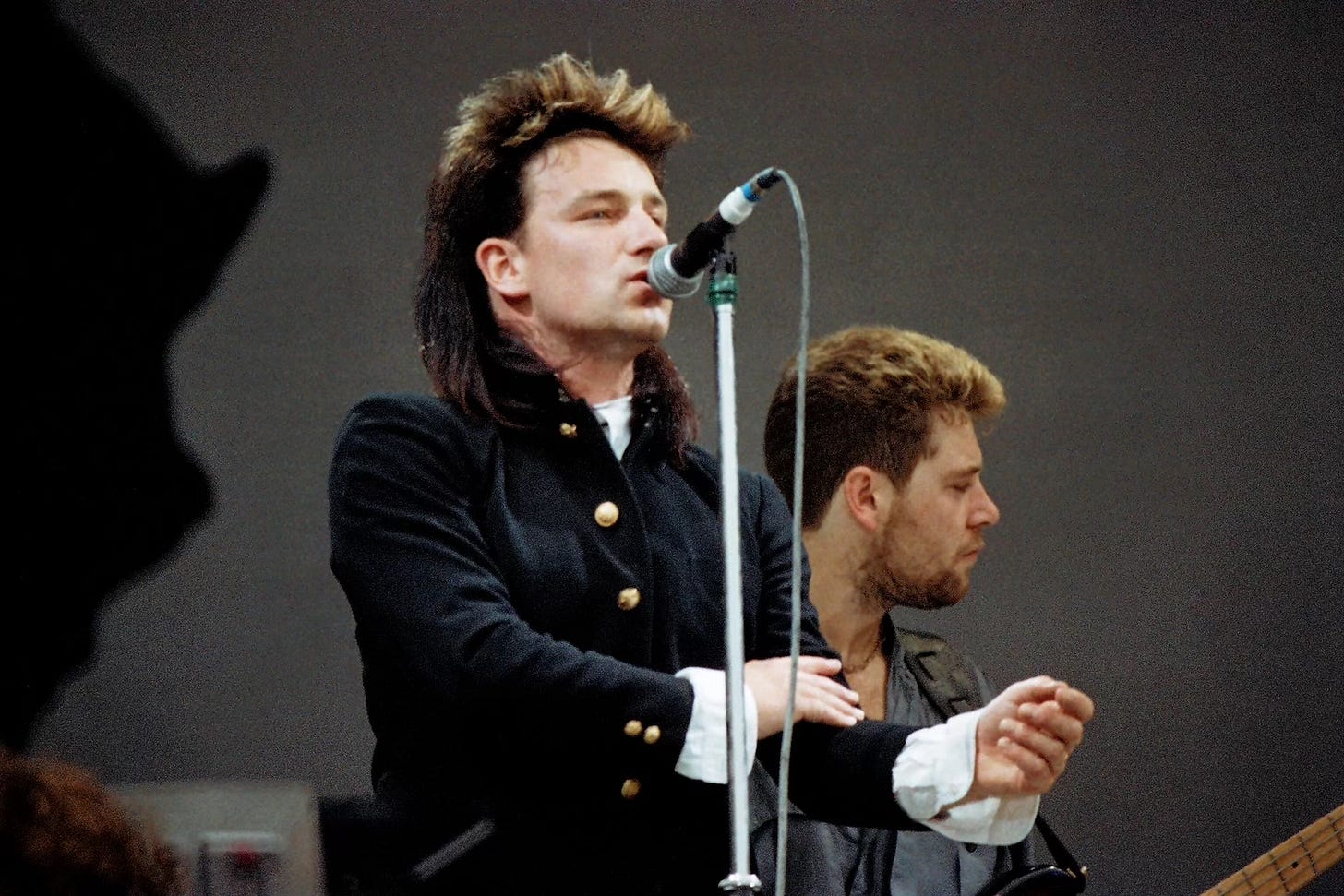Top 25 U2 Songs: Honorable Mentions (Part 2)
More songs by the Irish group that fell just short of my official Top 25 list.
Taking a break from the official countdown of my Top 25 U2 songs to talk about a few more honorable mentions. Is it a crime that any of these songs aren’t on my ultimate, final list? Let me know!
“Bad”
This was the song I was thinking of when I put “Indian Summer Sky” in my Top 25 and wondered if I was getting a little too cute. This track off of The Unforgettable Fire is one of the band’s biggest and most important songs, one that found its way onto their Best of 1980-1990 compilation. The song depicts and addresses heroin addiction, which Bono witnessed amongst those around him (and perhaps exacerbated by recession in Dublin in the early 1980s, leading to many turning to the drug).
I really enjoyed how the song was used during the Elevation Tour, just before “Where the Streets Have No Name.” Those two epic songs, one leading into another, struck a note that was the high point of the concert. One thing I’ve noticed is that the band will often have a song like “Bad,” one about suffering and pleading, that leads right into “Streets.” It’s a kind of atonement and then salvation structure in the setlist. “Bad,” “All I Want Is You,” “Please” during PopMart, “One” during U2 360 (as part of the encore), and a song I’m going to talk about in a second during ZooTV. A slight digression, but one prompted by thinking about “Bad.”
Though I think about its use during the Elevation Tour, how can you talk about Bad without mentioning the performance during Live Aid in 1985 that put U2… maybe not on the map but on a different map.
The performance of the song distilled much of what makes U2 a group beloved by so many—the theatricality, the sincerity.
From the Rock and Roll Hall of Fame’s Library and Archive:
During "Bad," Bono climbed out into the crowd and wrapped his arms around a female fan, creating a sense of intimacy in a massive audience, both in the stadium and those watching around the world. It cemented U2's image as a band that could make the big dramatic stadium gesture that feels personal.
The band’s performance went on so long that they were unable to play “Pride (In the Name of Love),” which was their biggest hit. The band had all thought they’d blown it when, in reality, they’d elevated themselves to the top of the heap of rock bands. I love that idea—that this thing that they thought was a catastrophe was, in reality, a thing that launched the band into a new stratosphere.
“Bullet the Blue Sky” and “Mothers of the Disappeared”
These Joshua Tree songs popping up in the honorable mentions is an indicator off that “no skips” quality of that album. “Mothers of the Disappeared” was one of the toughest songs to move from my official Top 25 list to the honorable mentions. While “40” is where the band got their reputation for great album closing songs, this one is one of my favorite. The song is… about/inspired by mothers in Argentina and Chile who had seen their children “disappeared” by the dictatorships in charge of those countries at the time. The counterpoint between the ominous electric sound to the rhythm and the beauty of the guitar from The Edge manifests sonically what occurred between these oppressive, dehumanizing forces and the beautiful humanity that stood up to it.
It’s a great counterpoint to “Bullet the Blue Sky,” which is also about the conflict in Central and South America in the 1980s, but “Mothers” brings forth the sadness while “Bullet” gives voice to a profound anger. After traveling to Nicaragua and El Salvador, Bono famously told the Edge to "put El Salvador through an amplifier.”
As one who finds Oscar Romero, who was assassinated for speaking out against the early injustices that would lead to the Salvadorian Civil War, it’s a track full of meaning. It’s also a moment for the band to really… rock. The Edge’s guitar work deservedly commands the attention, but Larry Mullen Jr.’s drumming on the song is equally powerful.
In concert, “Bullet” became a way for the band to speak about injustice (neo-Nazism, gun violence, religious intolerance). Much is made, along with many jokes, about U2’s political/moral conscience and how it appears in their music. But I don’t know how you can hear this combination, “Bullet” and “Mothers,” and think anything except to me moved (either to anger or sadness) by the band’s sincere engagement with these issues.
“Running to Stand Still”
Another great Joshua Tree track and the song that, during the ZooTV tour, would lead into “Where the Streets Have No Name.”
“Running” is song, like “Bad,” that depicts the struggle of heroin addiction that Bono witnessed in Dublin (the “seven towers” referring to high-rise flats that had a large addict population). In keeping with the Joshua Tree’s wading into the waters of more American music, the song is blues-ier than “Bad” and makes use of acoustic slide guitar. In contrast to the first four songs on Joshua Tree, which are epic in their scope and sound, “Running” is a much more intimate and small song, perhaps making it more relatable or something that could elicit a personal connection.
“Angel of Harlem”
Easily and without a doubt my favorite of the new songs to be included in Rattle and Hum, Angel of Harlem is another example of the group’s immersion into America and its musical culture. Here’s how Bono described the song’s genesis:
We landed in JFK and we were picked up in a limousine. We had never been in a limousine before, and with the din of punk rock not yet faded from our ears, there was a sort of guilty pleasure as we stepped into the limousine. Followed by a sly grin, as you admit to yourself this is fun. We crossed Triborough Bridge and saw the Manhattan skyline. The limo driver was black and he had the radio tuned to WBLS, a black music station. Billie Holiday was singing. And there it was, city of blinding lights, neon hearts. They were advertising in the skies for people like us, as London had the year before.”
The song itself was recorded at the famous Sun Studios in Memphis, Tennessee (as part of the studio tour, I’ve seen the room where the band recorded the song).
It’s a U2 song that’s a lot closer to the ground (though it’s a completely different song in subject matter and sound, it’s a bit like “Running to Stand Still” in that regard). Back when making mixtapes were a thing, it was one of a few U2 songs that you could use (because other ones were so big that they had their own gravity and didn’t really fit within a compilation).
I also enjoyed the performances of the song during the ZooTV tour, with Larry Mullen Jr. on the bongos, wholly acoustic, and the inclusion of a snippet from ABBA’s “Dancing Queen” (and then even got Björn Ulvaeus and Benny Andersson to join them on stage during the tour’s Stockholm stop).





